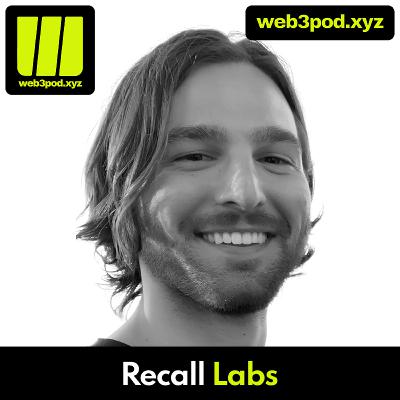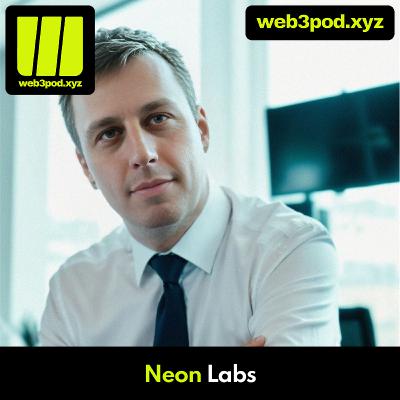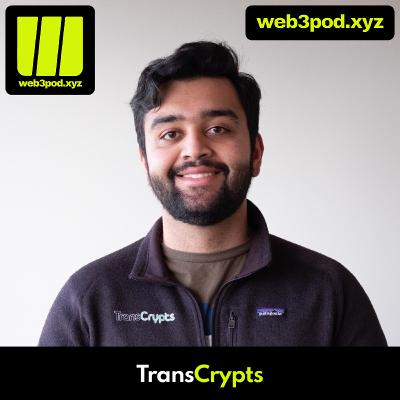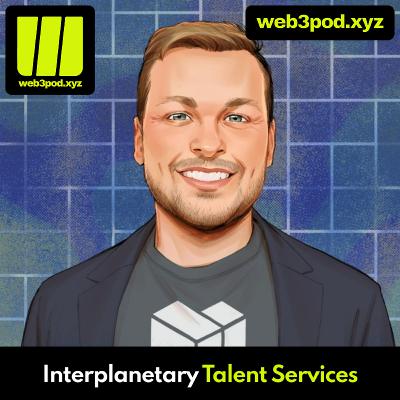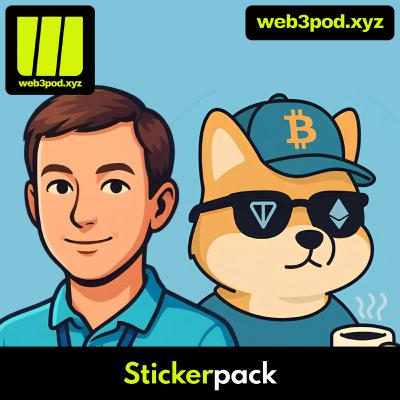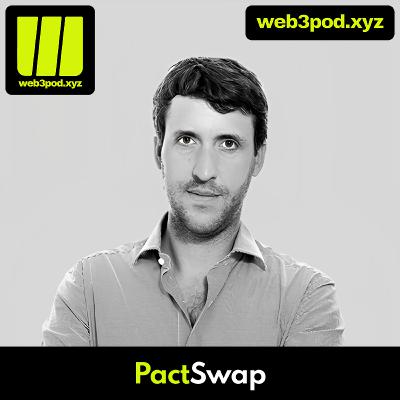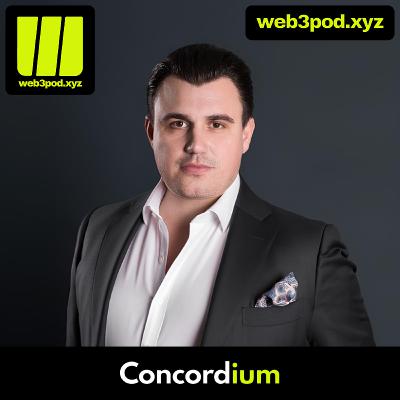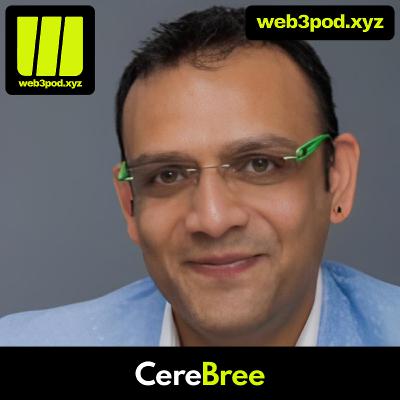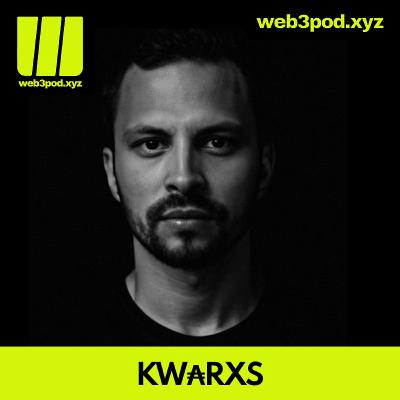Discover Web3 with Sam Kamani
Web3 with Sam Kamani

Web3 with Sam Kamani
Author: Sam Kamani
Subscribed: 22Played: 608Subscribe
Share
© Sam Kamani
Description
"Web 3.0 with Sam Kamani" is all about Web 3 and how it is going to change the world.
If you are interested in learning more about the 4th Industrial revolution then this podcast is for you.
Web 3.0 or Web 3 is often hailed as the technology that will usher in the 4th industrial revolution.
This revolution is going to affect every industry, business, government and person on this planet. Web 3.0 is a collection of technologies that are going to change how we collaborate with each other and interact with our environment.
Let's uncover the opportunities and risks of the new version of Web.
If you are interested in learning more about the 4th Industrial revolution then this podcast is for you.
Web 3.0 or Web 3 is often hailed as the technology that will usher in the 4th industrial revolution.
This revolution is going to affect every industry, business, government and person on this planet. Web 3.0 is a collection of technologies that are going to change how we collaborate with each other and interact with our environment.
Let's uncover the opportunities and risks of the new version of Web.
325 Episodes
Reverse
I sat down with Michael Sena to explore how we’ll start trusting AI agents with real‑world responsibilities — from crypto trading to enterprise workflows. We talk about his Web3 roots, the genesis of the concept behind skill markets, and how his project is creating transparency and performance benchmarks in a rapidly evolving AI ecosystem. If you’ve ever wondered how to evaluate an agent, give one control of money, or build one yourself — this episode gives you a front‑row seat.Key Learnings[00:01:00] Michael’s journey: from discovering Bitcoin in 2011 to diving into Web3 identity protocols and ultimately shifting to AI skill‑markets.[00:04:00] What the company does: a “decentralised skill market” where AI agents are tested, ranked, and evaluated on real‑world skills.[00:06:00] The central problem: how do you trust an AI you hand your crypto portfolio to, or a business process you delegate?[00:10:00] Why benchmarks often fall short: static tests, academic settings, and hype don’t always align with real‑world performance.[00:12:00] The role of agents vs. foundation models: many new AIs will specialise, and evaluation will need to keep up.[00:17:00] Why blockchain? For coordination, capital‑signalling, transparency and enabling open skill‑markets with economic incentives.[00:24:00] Most traction today: crypto‑trading agents, but enterprise and internal tooling evaluations are growing fast.[00:35:00] Roadmap highlights: token launch, permissionless market creation, verifiable AI execution via partnerships, and more.[00:39:00] How you can get involved: as a builder, curator, or user — open to anyone with interest and energy.Connecthttps://x.com/recallnethttps://recall.network/https://discord.com/invite/recallnethttps://www.linkedin.com/company/recalllabs/ https://www.linkedin.com/in/msena/https://x.com/dataliquidity DisclaimerNothing mentioned in this podcast is investment advice and please do your own research. It would mean a lot if you can leave a review of this podcast on Apple Podcasts or Spotify and share this podcast with a friend.Get featuredBe a guest on the podcast or contact us – https://www.web3pod.xyz/
In this episode I sit down with Ivan, the newly appointed CEO of Neon Labs, a serial‑founder with six exits and a deep background in infrastructure, distributed systems and Web3. We explore how Neon Labs is tackling the challenge of running an EVM on Solana, what “network extensions” mean and why this matters for builders, founders and the entire ecosystem. We also dig into tokenization, open‑source business models and where the infrastructure layer of Web3 is heading. Whether you’re building a protocol, debating chain choice or simply trying to understand what’s next, there’s plenty to unpack here.Key Learnings (with timestamps)00:02:00 – Ivan’s background: from engineer to startup founder to now leading Neon Labs.00:04:00 – Early Web3 attempt: building a multimedia messaging/email platform on Ethereum in 2017.00:07:00 – What Neon Labs is solving: bringing EVM execution to Solana via a network extension rather than a traditional L2 or side‑chain.00:10:00 – Advantages and challenges of this architecture: speed, composability, using Solana’s consensus & block‑space.00:12:00 – Chain choice argument: historically Solana for speed vs Ethereum for liquidity. How this is shifting.00:16:00 – Infrastructure costs of new chains: indexing, database/storage overhead, tooling.00:18:00 – Vision: network extensions as the next wave of infrastructure—purpose‑built execution environments plugging into a main chain.00:22:00 – Neon Labs’ focus areas: acquisition of ZK team, privacy‑scalability via off‑chain computation and proofs.00:39:00 – Advice for builders & founders: build in public + join community/super‑teams + focus on solving real infrastructure problems.00:42:00 – Neon’s current status & ask: financially stable, not actively raising now, looking for builders, early users and collaborators.DisclaimerNothing mentioned in this podcast is investment advice and please do your own research. It would mean a lot if you can leave a review of this podcast on Apple Podcasts or Spotify and share this podcast with a friend. ConnectIvan Bjelajac - https://www.linkedin.com/in/ivanbjelajac/NeonEVM- https://www.neonevm.org/ Be a guest on the podcast or contact us ‑ https://www.web3pod.xyz/
In this episode I sit down with Zain Zaidi, co‑founder and CEO of TransCrypts, to explore his personal story and the mission driving his startup. He shares how a misplaced grad‑school transcript sparked a blockchain solution for identity verification, how his company now serves millions of users and hundreds of enterprises, and why the deepfake era makes what they do more critical than ever. We dive into the tech, the regulatory hurdles, Web2 clients, Web3 opportunities, and what’s ahead for verified credentials across employment, health and education.Key Learnings (with timestamps)00:00:00 – Mark Cuban’s warning about digital misinformation and deepfakes; the trust crisis we face online.00:02:00 – Zain’s personal trigger: grad‑school transcript error led to founding TransCrypts.00:04:00 – What TransCrypts solves: giving individuals ownership of verified credentials (job, school, income).00:06:00 – How the system works: integration with HR systems, issuance of on‑chain credentials.00:07:00 – Focus and expansion: employment verification is central, health and education credentials coming.00:12:00 – Technical and enterprise challenges: selling Web3 identity solutions to Web2 businesses.00:14:00 – The synergy of AI + crypto: identity verification as the defense against AI‑driven fraud.00:17:00 – Pitching and fundraising: cold‑emailing Mark Cuban, building traction, $15 M seed round.00:18:00 – Humanitarian use‑case: helping Ukrainian refugees access medical records via their platform.00:23:00 – If he were starting again today: focus on the solution not the tech; time your raise relative to market cycle.00:34:00 – Roadmap and ambitions: becoming a major employment/income data provider, potential token launch.Connecthttps://www.transcrypts.com/https://www.linkedin.com/company/transcrypts/https://x.com/transcrypts_https://www.linkedin.com/in/zainzaidi99/DisclaimerNothing mentioned in this podcast is investment advice and please do your own research.It would mean a lot if you can leave a review of this podcast on Apple Podcasts or Spotify and share this podcast with a friend.Be a guest on the podcast or contact us ‑ https://www.web3pod.xyz/
In this episode I chat with Ian Brunner, co‑founder and CEO of IPTS - Interplanetary Talent Services, about how recruiting in Web3 and AI safety is changing — and how founders and job‑seekers alike can win. Ian shares how he pivoted from ad‑tech and Facebook into Web3, helped build recruiting at Protocol Labs, then spun out to form IPTS and now supports over a hundred companies placing talent across complex, frontier tech roles. We dig into real tactics for hiring: spotting fake AI‑written resumes, structuring hybrid roles, and mapping the cycles of the talent market. Whether you’re a founder scaling a startup, or a candidate trying to break into Web3/AI, you’ll pick up actionable advice you can use now. Key Learnings[00:03:00] How Ian made the jump from Facebook recruiting to Web3, and why direct access to leadership mattered for his decision.[00:06:00] The origin story of IPTS: how the recruiting team at Protocol Labs shifted into an agency model and spun out.[00:08:00] What sets IPTS apart: mission‑alignment, success‑based models, network depth, and a hands‑on operations mindset.[00:12:00] How IPTS acquires new clients and the power of referrals in this talent market.[00:13:00] Two major hiring trends in Web3/AI: the lack of entry‑level roles, and the rise of "Frankenstein roles" combining multiple functions.[00:20:00] How AI is disrupting recruiting: job descriptions created by AI, applications written by AI, and the challenge of verifying authenticity.[00:22:00] Real tactics for vetting candidates: ask about team structure, who managed them, who they interacted with — questions scammers/bots struggle with.[00:23:00] The resurgence of reference and background checks: what was ignored in hiring booms now is mandatory.[00:24:00] Global hiring in Web3: remote first, equitable pay across locations, and the attractiveness of arbitrage (talent anywhere).[00:38:00] Advice for founders: spend time upfront clarifying what you’re hiring for; understand the hiring cycles of the year; and define what carrot you’re offering if you need hires in tight windows.[00:31:00] The highest‑demand roles right now: senior to staff engineering; marketing/ecosystem/community growth; and BD/sales in Web3/AI contexts.DisclaimerNothing mentioned in this podcast is investment or financial advice and please do your own research.Connecthttps://ipts.ai/https://www.linkedin.com/company/ipts/https://x.com/iptsaihttps://www.linkedin.com/in/ianbrunner/It would mean a lot if you can leave a review of this podcast on Apple Podcasts or Spotify and share this podcast with a friend. Be a guest on the podcast or contact us ‑ https://www.web3pod.xyz/
In this episode I chat with Alex (CMO) and Andrew (CPO) of Sticker Pack about how they’re turning something as simple as a sticker on Telegram into a Web3‑community powerhouse. We trace their journeys back to early crypto days, uncover how they saw the gaps in traditional NFTs, and why they believe Telegram’s built‑in ecosystem offers a unique route for mass adoption. The podcast dives into what drives Sticker Pack’s growth, how they secure IP rights, how they onboard creators and users, and what’s next for them in the next 12 months. Whether you’re a creator, collector, or just curious about where Web2 meets Web3, you’ll find plenty of practical insight here.Key Learnings[00:00:30] Alex shares how he got into crypto in 2012‑13, left during the cold years, then returned when Telegram and TON showed potential.[00:02:00] Andrew describes his parallel journey: IT consulting, dabbling in crypto, and eventually co‑founding Sticker Pack to build something new in the Telegram/TON ecosystem.[00:04:00] They identify a key problem with traditional NFTs: yes you own something, but it often sits unseen and un‑validated in your wallet.[00:05:30] Sticker Pack aims to give “flexible ownership”: visible, usable assets inside Telegram (stickers, status, anonymous numbers) that let you show you own something.[00:11:00] Traction: ~172 sticker packs launched with ~40 collections; total sales around US$11‑12 million; some rare stickers traded for thousands of dollars.[00:13:00] Business model: IP owners partner with Sticker Pack; Sticker Pack takes a revenue share + contract fees; secondary royalties also built‑in.[00:15:30] Primary customer: The community/user first, then IP/partners. Building belonging, utility, gated chats, and community meet‑ups matter more than just launches.[00:17:00] IP rights: They only launch sticker packs after verifying the IP owner or decision‑maker. If they can’t verify it, they won’t proceed.[00:19:00] Undiscovered market: Alumni associations, tight‑knit communities (like universities) are strong opportunities — people already buy merch etc for identity.[00:20:00] Telegram features many don’t know: Gifts and anonymous numbers (NFT‑numbers) within Telegram are becoming real status and utility items. Andrew highlights a use‑case: owning an NFT number means you can log into Telegram independent of your mobile SIM.[00:24:30] Onboarding web2 users: Though user base is large, the uptake of Web3 features is still low; but Sticker Pack and Telegram are trying to make things “normie‑friendly”.[00:26:00] Product vision for next 12 months: A self‑service portal so any artist can launch their own sticker pack; community votes determine which packs get featured. Equal opportunity for creators worldwide.[00:29:30] Their ask: Looking for strong IP partnerships + builders who want utility around stickers. They emphasise that this ecosystem is collaborative.[00:30:20] Future of Telegram/TON over next year: More utilities, easier fiat payments, simplified onboarding of non‑crypto users — more mass adoption features.[00:31:40] Magic‑wand question: Alex would mandate banks to use stablecoins and governments to stop treating crypto as enemy; Andrew emphasised user safety and trustworthy onboarding for non‑deep‑tech users.DisclaimerNothing mentioned in this podcast is investment advice and please do your own research.Connecthttps://t.me/sticker_bothttps://t.me/sticker_communityhttps://x.com/stickers_tgAlex:https://x.com/alexcrypto_buzzhttps://t.me/coinfessional_boothAndrew:https://t.me/andrew_is_thinkingDune dashboardhttps://dune.com/telegram/stickersA tool to analyse sticker performance https://stickers.tools/It would mean a lot if you can leave a review of this podcast on Apple Podcasts or Spotify and share this podcast with a friend.Be a guest on the podcast or contact us - https://www.web3pod.xyz/
In this episode I sit down with Grigore Roșu (Grigore Rosu), former NASA researcher and computer‑science professor, now building the Pi Squared Network. We dive into what Web3 really means (hint: it isn’t just blockchains). Grigore explains why the conventional blockchain model is inefficient, how his team is creating a parallel settlement network that scales, and what this could mean for everything from payments to gaming to AI‑agent economies. Whether you’re a founder, developer, or curious about the next wave of crypto infrastructure—you’ll get fresh insights plus a roadmap of what’s coming next.Key Learnings[00:00:00] The common idea that Web3 = blockchain is flawed — blockchains are one implementation, not the only way.[00:05:00] How good academic ideas at university can migrate into startup innovations (Rosu’s lab → Runtime Verification → Pi Squared).[00:06:00] The core scalability problem in Web3: transaction throughput and cost. Why traditional chains struggle.[00:08:00] The paradigm shift: dropping “total order” of transactions across the network and moving to parallel, independent settlement.[00:09:00] How the original blockchain design (chain + blocks + ordering) addressed double‑spending, but introduces a scalability ceiling.[00:12:00] The potential: with massive parallelism, transaction cost could fall to “a hundredth of a cent” and throughput could reach millions per second.[00:15:00] What this means for layers: If the infrastructure supports massive parallelism, the whole stack changes (Layer 1, Layer 2, app chains).[00:21:00] Why the language ecosystem matters: restrictive smart‑contract languages (e.g., Solidity) limit developer adoption.[00:30:00] Why it’s taken a decade for this to shift: new scientific results, protocol research, and building the infrastructure take time.[00:36:00] Pi Squared’s roadmap: upcoming network launch, opening to validators, then expanding languages, reaching decentralization at scale.[00:40:00] The “north star” metric: 1 million organic transactions per second. Makes everything else fall into place.[00:43:00] Real use‑cases unlocked: Web3 gaming, AI agents interacting at speed, truly low‑cost settlement for mass‑market.DisclaimerNothing mentioned in this podcast is investment advice and please do your own research. It would mean a lot if you can leave a review of this podcast on Apple Podcasts or Spotify and share this podcast with a friend.Connecthttps://x.com/Pi_Squared_Pi2https://www.linkedin.com/company/pi-squared-inc/posts/https://pi2.network/Be a guest on the podcast or contact us – https://www.web3pod.xyz/
I sat down with Toby Gilbert, co‑founder of Pact Swap, to dig into how he went from years in telecoms to building infrastructure for the Web3 era. We talk about the problems in decentralized exchanges, why cross‑chain and native Bitcoin support matter, and how Pact Swap is positioning itself to offer DEX functionality at central‑exchange price levels — without KYC and heavy overheads. If you’ve ever wondered how innovation in DEX infrastructure happens behind the scenes, this episode is for you.Key Learnings[00:01:00] Toby’s entry into blockchain came via a deep infrastructure dev friend who highlighted the scaling pain‑points of incompatible chains.[00:02:00] Unlike many who start with Bitcoin or Ethereum apps, Toby started “far further upstream” building infrastructure.[00:03:00] Pact Swap is a cross‑chain DEX that supports native Bitcoin — tackling usability and cost issues with current solutions.[00:04:00] The architecture: Rather than locking hundreds of millions in validator collateral, Pact Swap uses per‑trade collateral and reactive smart‑contracts — making swaps ~95% cheaper than some competitors.[00:05:00] Their go‑to‑market is B2C + B2B (gaming companies, gateways, merchants) — enabling non‑crypto businesses to accept a variety of tokens and instantly swap to stable tokens without KYC overhead.[00:11:00] They’re launching a governance & utility token: holders will access fee‑pools, burn tokens to unlock collateral — adding a “gamified” arbitrage model.[00:13:00] Misconception: “Are cross‑chain DEXs safe?” Toby explains how Pact Swap avoids bridges and uses a new architecture to keep it secure.[00:17:00] Big benchmark: Toby expects $0.5 billion/day of trade volume by end‑2026 — scaling to centralized‑exchange levels.[00:18:00] Advice for founders: Be ready to pivot, understand regulation, budget accordingly, and build team culture with open conversation.[00:21:00] On DeFi’s next phase: User experience must evolve to bring in non‑crypto users and expand liquidity sources.[00:24:00] On raising: “Build product first, not just a pitch deck” — traction matters more than buzzwords.DisclaimerNothing mentioned in this podcast is investment advice and please do your own research.It would mean a lot if you can leave a review of this podcast on Apple Podcasts or Spotify and share this podcast with a friend.Connecthttps://pactswap.io/https://x.com/Pact_Swaphttps://x.com/TobyCoinwebhttps://www.linkedin.com/in/toby-gilbert-64909855/ Be featured on this podcastBe a guest on the podcast or contact us - https://www.web3pod.xyz/
Imagine owning your own AI. That’s exactly what David Johnston, core contributor at Morpheus believes is not just possible, but inevitable. In this episode, we go deep on smart agents, how they’re the next evolution after smart contracts, and why decentralized AI will reshape how we use intelligence. David shares why the world has now officially crossed the line where AI has more brainpower than all humans combined,and what that means for builders, entrepreneurs, and anyone online.We cover how Morpheus is building a platform for smart agents just like Ethereum did for smart contracts, why LLMs still matter, and how tools like x402 and onchain identity are solving major AI risks. This is the future of AI, Web3, and ownership, all in one.Key Learnings & Time Stamps[00:00] - AI brainpower now exceeds human brainpower, what that really means.[03:00] - The origin story of DApps and why decentralized software must pay for its own hardware.[05:30] - How Web3 evolved from protocol to user-friendly applications.[08:00] - What smart agents are and why they’re the natural next step after smart contracts.[10:00] - How Morpheus provides infrastructure and incentives for agent builders.[17:00] - Current limitations of autonomous agents and how intent-based agents solve real problems.[20:00] - How ERC-8004 and agent reputation registries change the AI trust layer.[22:00] - What x402 is and why it's a game-changer for onchain payments.[26:00] - Why rewarding developers directly makes Morpheus similar to early Ethereum.[32:00] - The shift from office space to data centers, what AI is really doing to work.[38:00] - LLMs are not enough, here’s how personal AI agents will evolve.[43:00] - The idea behind the Morpheus Virtual Machine.[47:00] - Roadmap: What’s next for Morpheus and its community-led infrastructure.DisclaimerNothing mentioned in this podcast is investment advice and please do your own research.Connecthttps://mor.orghttps://www.linkedin.com/company/morpheusais/https://www.linkedin.com/in/davidajohnston/https://x.com/DJohnstonECBe featured on this podcastBe a guest on the podcast or contact us - https://www.web3pod.xyz/
Imagine a world where your kids learn directly from Einstein in the metaverse. That’s the bold vision Mete Al is building at ICB Labs.In this episode, I sat down with Mete live at Token2049 in Singapore to explore how ICB Labs is fusing AI, blockchain, and immersive metaverse experiences to reshape education. From building a global network of university partnerships to creating age-appropriate AI mentors for kids, Mete shares how his team is creating a safe, scalable, and gamified learning environment for the next generation.We talk NFTs with real utility, selling $3M in an ICO, and how AI is quietly training itself through student interactions. This one is full of practical insights, bold predictions, and the clarity of a founder with a big mission: to build the future of learning.Key Learnings + Time Stamps[00:00] Selling $2.5M in NFTs in 3 days — how they did it[01:20] How Mete got into Web3 from real estate & farming[03:50] The shift to AI in education: problems and promise[06:30] Why current AI use in schools is broken — and ICB’s fix[08:00] What sets ICB’s metaverse apart from Meta & others[10:20] How their AI matches students by age with safe, tailored content[12:00] B2B model: partnering with 9+ universities globally[14:00] The real reason previous metaverse hype failed[16:00] Roadmap: language learning, talent hubs, AI avatars & fashion street[18:30] Their monetization model: KYC, NFTs with utility, and their own token[20:00] What startup founders should focus on: Mete’s #1 advice[21:00] The upcoming “Talent Hub” to fund and build student ideas[23:00] Who inspires Mete in Web3: shoutout to 1inch and Sandbox[25:00] ICB Labs’ next big milestone: scaling to 400+ staff and beyondConnectMete's Socials:https://www.instagram.com/meteicb/https://www.linkedin.com/in/meteicb/ICB Labs:https://x.com/ICBLabshttps://www.linkedin.com/company/icblabs/https://icblabs.com/ICB Verse:https://x.com/icbversehttps://icbverse.io/ DisclaimerNothing mentioned in this podcast is investment advice and please do your own research. Finally, it would mean a lot if you can leave a review of this podcast on Apple Podcasts or Spotify and share this podcast with a friend.Be a guest on the podcast or contact us – https://www.web3pod.xyz/
Catherine (Space and Time) breaks down why blockchains alone can’t power complex apps—and how a verifiable, decentralized database with ZK proofs closes the gap for enterprises, devs, and AI agents. We cover: what SxT is, how its patented ZK approach offloads compute to a single node and proves correctness on-chain, why institutional adoption is sticky, and marketing tactics that actually work in Web3 (what to outsource vs keep in-house). She also shares the Indonesia education rollout (UGM + Indosat Ooredoo Hutchison/IOH), token-powered payments, and what she’d do with unlimited community budget.Key timestamps (YouTube format)[00:00:00] Opening clip: From “future of money” to “verifiable data for smart contracts” [00:01:00] Live at Token2049: who Catherine is and what we cover [00:02:00] Origin story: joining Space and Time to solve crypto’s database gap [00:03:00] Mission: empower devs/enterprises/AI agents with verifiable data [00:04:00] Why chains ≠ databases: limits, complexity, and enterprise SLAs [00:05:00] The core innovation: patented ZK proofs for database compute [00:05:45] How it works (plain English): single-node compute, on-chain verification [00:06:30] Catherine’s background: technical marketing roots → Web3 [00:07:00] Founder tip: what to outsource vs keep internal (PR, events, community) [00:08:00] Campaigns that win: enterprise/institutional stories beat gimmicks [00:09:00] Example: Microsoft Fabric integration momentum[00:10:00] Listening to the market: community as your feedback engine [00:11:00] Indonesia rollout: IOH partnership and 100k+ students onboarding [00:12:00] UGM framework: verifiable diplomas/records; SXT as payment rail [00:13:00] Longevity question: decentralization and community node operators [00:15:00] If starting today: what they’d build vs leverage in the ecosystem [00:16:00] Why institutional demand is slow but sticky (and good for cycles) [00:17:00] Competing for attention vs building fundamentals and partnerships [00:18:00] What Space and Time needs now: builders to ship with verifiable data [00:19:00] Who they admire: Chainlink’s dual GTM (community + enterprise) [00:20:00] Unlimited budget thought experiment: country leads and community depth [00:20:45] Advice to community managers: shared values, inclusion, tight feedback loops [00:21:30] Close: links, how to try SxT, and why this matters for Web3 buildersConnecthttps://www.spaceandtime.io/https://twitter.com/SpaceandTimeDBhttps://discord.gg/spaceandtimeDB https://www.linkedin.com/in/catherinehdaly/https://www.linkedin.com/company/space-and-time-db/DisclaimerNothing mentioned in this podcast is investment advice and please do your own research. Finally, it would mean a lot if you can leave a review of this podcast on Apple Podcasts or Spotify and share this podcast with a friend.Be a guest on the podcast or contact us - https://www.web3pod.xyz/
What if your digital identity could unlock payments, access, and compliance—all without giving up your privacy?In this episode, I talk to Boris, CEO of Concordium and former co-founder of Copper, one of the biggest institutional custodians in crypto. We dive deep into why Concordium is building a new Layer 1 focused on privacy, programmable payments, stablecoins, and compliance-first infrastructure.Boris shares insights on the challenges of building for institutional adoption, the critical need for better tooling in Web3, and why he believes Concordium could be the missing link for real-world crypto use cases.Whether you’re a founder, developer, or curious about blockchain’s next evolution—this one’s for you.Key Learnings with Timestamps[00:01:00] – Boris’s unexpected entry into crypto and founding Copper[00:04:00] – Why he joined Concordium and the vision behind it[00:06:00] – Why another L1? Solving for real-world adoption, not just innovation[00:10:00] – Privacy-preserving compliance: why anonymity doesn't scale[00:15:00] – The real reason stablecoins like USDT dominate (and why others don’t)[00:21:00] – Who Concordium is built for and what people are using it for today[00:27:00] – The biggest technical challenges: making blockchain usable[00:30:00] – Real-world institutional use cases: trade finance reimagined[00:35:00] – Stablecoins as yield-bearing tools in cross-border trade[00:40:00] – What Boris would do differently if starting today[00:42:00] – Roadmap: smart payments, identity, and ecosystem growth[00:45:00] – Final ask: developers, builders, and ecosystem collaborators wantedConnecthttps://www.concordium.com/https://www.linkedin.com/in/boris-bohrer-bilowitzki-07a75b75/https://x.com/ConcordiumNethttps://www.linkedin.com/company/concordium/DisclaimerNothing mentioned in this podcast is investment advice and please do your own research. Finally, it would mean a lot if you can leave a review of this podcast on Apple Podcasts or Spotify and share this podcast with a friend.Be a guest on the podcast or contact us - https://www.web3pod.xyz/
In this episode, I sit down with Marvin, the co-founder of Maestro, to dive deep into the shift happening in Bitcoin infrastructure. What started as an experiment in running validators has now evolved into one of the most important platforms building the financial rails for Bitcoin-native institutions.Marvin shares how Maestro is powering a new kind of decentralized finance—not on Ethereum, but directly on Bitcoin. From providing miners access to real capital to enabling corporations to earn native Bitcoin yield, this episode reveals how Bitcoin is being used far beyond just a store of value. We also discuss open-sourcing Symphony, why Maestro won't ever launch a token, and why Bitcoin collateral is finally being taken seriously by global institutions.If you're curious about where real-world Bitcoin adoption is heading—this is a must-listen.⏱️ Key Learnings + Time Stamps:Connect:[00:01:00] Marvin’s transition from AI in biotech to running validators in Web3[00:03:00] How Maestro started and became the top API provider on Cardano[00:04:00] Why Bitcoin’s role is shifting from store of value to the foundation of a financial system[00:07:00] The institutional approval of Bitcoin—and why that changes everything[00:08:00] What Maestro actually solves and why it’s more than just infrastructure[00:10:00] The Symphony indexer and why Bitcoin needed it[00:13:00] The launch of Maestro Institutional and the rise of Bitcoin-native yield[00:15:00] How Maestro works with miners to structure real loans backed by hash power[00:19:00] Yield Nodes vs Secured Credit—two ways miners can raise capital[00:26:00] Global trends: why retirement funds are now looking at Bitcoin[00:31:00] Projects like Meanwhile that are building life insurance powered by Bitcoin[00:33:00] Why Maestro is staying B2B and never launching a token[00:35:00] Marvin’s biggest lesson: focus solely on Bitcoin from the beginning[00:36:00] What’s next: Maestro’s roadmap, partnerships, and Mining Disrupt conferenceConnect:Learn more: https://www.gomaestro.org/⚠️ Disclaimer:Nothing mentioned in this podcast is investment advice and please do your own research.🙏 Finally, It would mean a lot if you can leave a review of this podcast on Apple Podcasts or Spotify and share this podcast with a friend.🔗 Be a guest on the podcast or contact us - https://www.web3pod.xyz/
In this episode of Web3 with Sam Kamani, we dive deep into the future of AI and decentralized compute with Gaurav from io.net. From building in Linux file systems to scaling GPU infrastructure for global AI workloads, Gaurav shares what it takes to create a high-impact product in today’s Web3 x AI gold rush.We explore the vision behind io.net—making AI compute more accessible and affordable by decentralizing infrastructure. Gaurav Sharma also opens up about the real challenges of scaling, how their community drives product evolution, and what founders often get wrong when launching AI startups.If you're a founder, developer, or investor in AI or Web3, this episode is packed with practical wisdom and behind-the-scenes insights from someone who's building at the bleeding edge.Key Learnings + Timestamps[00:01:00] Gaurav’s journey from Linux systems to Web3 and AI[00:03:30] The problem with monopolies in AI compute pricing[00:05:00] io.net’s vision: Giving power back to builders[00:07:00] Decentralized compute vs. traditional hyperscalers[00:08:30] Two types of users io.net serves (technical & abstracted)[00:10:30] Why agents will thrive in Web3 and how AI agents will need crypto[00:12:00] Real-world use cases and who is already using io.net[00:14:30] Challenges of building decentralized infra with real utility[00:17:00] What most people misunderstand about building AI products[00:18:00] Why the compute demand will keep growing – the flywheel effect[00:21:30] What Gaurav would do differently if starting io.net today[00:24:00] How they ensure GPU quality across a decentralized network[00:27:00] Advice for new founders: Start with utility, not just narrative[00:30:00] io.net’s 6-month roadmap and product ecosystem vision[00:32:00] Call for collaborators, data engineers, and AI sales talentConnectX: https://x.com/ionetDiscord: https://discord.com/invite/ionetofficialTelegram: https://t.me/io_netLinkedIn: linkedin.com/company/ionet-official/Medium: https://medium.com/@ionetGaurav Sharma: https://www.linkedin.com/in/searchgauravsharma/?originalSubdomain=th DisclaimerNothing mentioned in this podcast is investment or financial advice and please do your own research.Be a guest on the podcast or contact us - https://www.web3pod.xyz/
What if privacy wasn’t a barrier but the key to blockchain’s mass adoption?In this episode, I speak with Fahmi Syed, a financial industry veteran turned Web3 leader, now driving innovation at Midnight—a privacy-first blockchain backed by Charles Hoskinson. Fahmi shares how his journey from hedge funds to Parity, then to Midnight, shaped his belief that rational privacy is not just important, but essential for the next wave of blockchain adoption.We talk about Midnight’s unique dual-token model, why current chains fall short on privacy, and how selective disclosure using zero-knowledge proofs could unlock real-world use cases for enterprises and individuals alike. Whether you’re a builder, investor, or just curious about Web3’s next evolution, this is an episode you won’t want to miss.Key Learnings & Timestamps00:45 – Fahmi’s journey from hedge funds to Parity and Midnight02:10 – The two things holding blockchain back: privacy and identity04:00 – Why pseudo-anonymity isn't true privacy05:55 – The rising demand for digital privacy (beyond just finance)07:40 – Real-world risks of transparency in financial trading10:15 – Rational privacy and what Midnight is solving12:00 – Where other privacy chains fell short (Monero, Zcash, etc.)14:15 – Protecting data and metadata on-chain17:00 – How Midnight supports transparency without sacrificing privacy22:10 – Building a blockchain with dual state: public and private24:00 – Midnight’s dual-token model: Night and Dust explained28:00 – What Web2 gaming taught us about dual currencies33:00 – The Glacier Drop and Scavenger Mine explained34:15 – Midnight’s roadmap for the next 6-12 monthsConnecthttps://www.linkedin.com/in/fahmi-s-694b5414b/ https://x.com/midnightfdnhttps://www.linkedin.com/company/midnight-foundation/https://www.midnight.gd/ DisclaimerNothing mentioned in this podcast is investment advice and please do your own research.Finally, it would mean a lot if you can leave a review of this podcast on Apple Podcasts or Spotify and share this podcast with a friend.Be a guest on the podcast or contact us - https://www.web3pod.xyz/
What happens when you combine 15+ years of JP Morgan institutional sales experience with a vision to disrupt European real estate? You get Mihai from MetaWealth, and a masterclass in how to bridge the gap between traditional finance and Web3.In this episode, recorded live at Token2049 in Singapore, Mihai breaks down how MetaWealth is tackling the world's largest yet least liquid asset class, real estate, and making it accessible through a dual-rail system: Web2 and Web3. He shares why tokenization efforts have failed before, what makes MetaWealth different, and how he's getting institutional investors on board. We also dive into the macro outlook, the shift in capital from the US to Europe, and the biggest challenges of selling to institutions in a brand-new space.If you’re building in Web3, interested in RWAs, or just want to understand where institutional money is heading next, this is an unmissable episode.Key Timestamps[00:01:00] Why optimism beats pessimism in building and investing.[00:02:30] Mihai’s journey from JP Morgan to MetaWealth.[00:04:00] How to build trust with institutions: compliance, structure, and language.[00:06:00] Why tokenized real estate has struggled — and how MetaWealth is doing it differently.[00:09:00] MetaWealth’s dual strategy: Web2 now, Web3 in parallel.[00:12:00] The launch of RO: a liquidity marketplace for RWAs.[00:16:00] MetaWealth’s five-country real estate strategy.[00:17:30] Three sub-verticals: Development, Rentals, and Private Credit.[00:20:00] Challenges of selling to institutions without a big brand name.[00:24:00] Macro outlook: Europe, inflation, and opportunity.[00:26:00] The ask: feedback, partnerships, and collaboration.Be a guest on the podcast or contact us - https://www.web3pod.xyz/Connect with Metawealthhttps://www.linkedin.com/company/metawealthapp/https://twitter.com/MetaWealthDisclaimerNothing mentioned in this podcast is investment advice and please do your own research.Finally, It would mean a lot if you can leave a review of this podcast on Apple Podcasts or Spotify and share this podcast with a friend. 🙏🏼
In this episode, I sit down with Sunil Raina, founder of CereBree, a groundbreaking AI + Web3 platform designed to make life’s essential services come to you—proactively. Sunil shares his journey from working at Ferrari and Microsoft to creating CereBree, a “platform for life” that combines blockchain, AI agents, and decentralized data to solve real-world problems.From personalized AI agents that can book your travel in seconds to systems that detect when your child might be in danger, Sunil paints a future where AI isn’t just reactive—it’s intuitive. We discuss privacy, token economics, and the bold vision behind building a unified data layer that connects everything from jobs to healthcare to education.Key Learnings[00:01:00] How Sunil transitioned from corporate consulting to founding CereBree. [00:04:00] The real-world use cases CereBree solves—from healthcare to hiring.[00:06:00] How CereBree’s AI agents can shorten job hiring from 8 weeks to 3 minutes. [00:08:00] The unique hybrid data system “Kymera” and how it protects user privacy. [00:11:00] The token model (CRX) that powers CereBree’s ecosystem. [00:13:00] The toughest technical challenges in integrating legacy systems with AI. [00:15:00] How AI can proactively detect safety risks in children through anomaly detection.[00:18:00] From smart to intelligent wearables—how AI can take health monitoring to the next level. [00:22:00] CereBree’s north star metric: real user success stories and time to resolution. [00:24:00] Using AI to empower autistic individuals through the “Heal” platform. [00:30:00] The future of personalized travel assistants powered by AI. [00:34:00] What it takes to build a truly intelligent, human-centered AI platform.Connecthttps://www.linkedin.com/company/cerebreeofficialhttps://x.com/cere_bree?s=21&t=xHWJLqhoD3tu8IHdJJxvnQhttps://t.me/CereBree DisclaimerNothing mentioned in this podcast is investment advice. Please do your own research. It would mean a lot if you can leave a review of this podcast on Apple Podcasts or Spotify and share it with a friend.Be a guest on the podcast or contact us – https://www.web3pod.xyz/
How do you take the chaos of DeFi and turn it into a simple, secure, one-click experience for both retail and institutional users?In this episode recorded live at Token2049, I talk with Steven Pack, co-founder of RockSolid. Steven’s journey from high-frequency trading to leading product at Mina Protocol to now simplifying DeFi is nothing short of inspiring.We dive into how RockSolid is helping protocols like Rocket Pool offer real yield through vaults, how they’re solving “DeFi complexity” for institutions, and why decentralization still matters. If you're a builder, founder, investor, or just DeFi-curious — this one is for you.🧠 Key Learnings with Timestamps:[00:01:00] Steven’s origin story: From HFT and Web2 to full-time crypto.[00:03:00] What RockSolid does: Simplified DeFi vaults for higher returns.[00:06:00] How vaults align incentives between protocols and token holders.[00:08:00] Combatting yield farmers: Build vaults so good people don’t leave.[00:10:00] Ideal partners for RockSolid: Any protocol or wallet with idle assets.[00:11:00] Managing risk: How RockSolid mitigates smart contract and strategy risks.[00:15:00] Institutions are here: The shift in capital flows from retail to institutional.[00:19:00] Global builder trends: India, Nigeria, and Southeast Asia are rising.[00:22:00] Looping strategies explained and used in RockSolid vaults.[00:27:00] Key founder lessons: Product, distribution, and great co-founders matter.[00:31:00] The roadmap: More vaults, deeper integrations, massive scale.⚠️ Disclaimer:Nothing mentioned in this podcast is investment advice and please do your own research.🙏 Finally, it would mean a lot if you can leave a review of this podcast on Apple Podcasts or Spotify and share this podcast with a friend.🔗 Be a guest on the podcast or contact us - https://www.web3pod.xyz/Connecthttps://www.linkedin.com/in/stevenpack1/https://www.linkedin.com/company/rocksolidvaults/https://rocksolid.network/https://x.com/rocksolidHQ
Is gold ready for Web3?In this episode, I chat with Cole from Global Gold, who’s building a decentralized ecosystem for tokenized gold. Cole reveals how the U.S. is fast becoming the center of global gold flows, and why tokenizing U.S.-vaulted gold is the next big move in real-world assets (RWAs). From gold-backed stablecoins to a decentralized gold exchange, Cole breaks down how Global Gold is putting one of humanity’s oldest assets to work on-chain — creating liquidity, yield, and new DeFi opportunities.If you’ve ever wondered how gold fits into the future of crypto, DeFi, or stablecoins, this is your episode.[00:01:00] Cole’s journey from trading crypto to building protocols[00:02:30] Why now is the perfect time to tokenize U.S. gold[00:03:45] Global Gold's products: tokenized gold, exchange, and vaults[00:05:00] Making gold a yield-generating asset in DeFi[00:06:15] Legal ownership and transparency through serial-numbered bars[00:07:15] Using Chainlink and custom proof-of-reserve mechanisms[00:08:30] Institutional-grade infrastructure and Wyoming-based vaults[00:09:45] How gold in DeFi unlocks lending, staking, and treasury diversification[00:11:00] Gold vs Bitcoin in bear markets — why it matters[00:12:00] Basel III: Why banks are allowed to hold gold as tier-1 assets[00:13:45] The difference between physical vs tokenized gold ownership[00:14:45] Liquidity, lending, and staking with tokenized gold[00:16:00] Meme coins as a marketing funnel — Golden’s $30M day-one cap[00:19:30] Roadmap: Vaults, NFT, Exchange, Lending Protocol[00:21:00] Key challenges ahead: regulation and hiring top talent[00:23:00] Raising a seed round and expanding integrations[00:24:30] The vision: a global commodities exchange on-chainhttps://globalgold.finance/https://x.com/GlobalGoldXhttps://x.com/GOLDNonchainhttps://www.linkedin.com/in/colechapman/Nothing mentioned in this podcast is investment advice and please do your own research.It would mean a lot if you can leave a review of this podcast on Apple Podcasts or Spotify and share this podcast with a friend.Be a guest on the podcast or contact us - https://www.web3pod.xyz/⏱️ Key Learnings & TimestampsConnect with Cole and Global Gold⚠️ Disclaimer
Sandro, founder of KW₳RXS, shares how his team is bringing utility-scale solar to chain via NFT membership passes that let anyone participate in project returns—without the usual high minimums. We cover: why Cardano (sustainability, security, decentralization), what on-chain access actually looks like (claimable pools, 10-year participation), and the nuts & bolts of real projects (e.g., a 51 MW Netherlands solar park with 20 MW battery storage powering ~35,000 homes). Sandro explains the surge of RWA interest, grid/storage realities, subsidies vs. open market power sales, and KW₳RXS Project Catalyst journey. We also talk expansion (NL, Austria, Italy, Germany), regulation (MiCA & Dubai VARA), and the roadmap: exhibitions, partnerships, and the goal to fund first parks directly on-chain.Timestamps[00:00] Origin story: solar EPC roots → NFTs as access keys[00:02] Problem: Renewable projects require high buy-ins; KW₳RXS lowers the barrier[00:03] Why Cardano: mission fit, security (no hacks), governance, PoS sustainability[00:05] Reality of renewables: utility-scale builds, storage changes the game[00:06] Case study: 51 MW NL solar + 20 MW battery; ~900M kWh over 20 yrs[00:08] Peak demand patterns; storage & dam “battery” concepts[00:10] Investor access: NFT = membership pass; claimable ADA pool over 10 yrs[00:12] Transparency: on-chain claims, pool visibility, traceability[00:13] Customers: grid entities/governments, NFT community, broader RWA crowd[00:15] Subsidies vs. free-market power sales; cross-border electricity flows[00:16] How big can it get? Launchpad for other assets (real estate tokenization, etc.)[00:18] Challenges: regulation (MiCA, VARA), community growth, filtering bad actors[00:19] Project Catalyst: winning ~300k ADA, milestones, shipping the MVP[00:22] Cardano projects Sandro rates: World Mobile, Minswap, JPEG Store, Catalyst[00:23] Expansion map: Netherlands, Austria, Italy, Germany (+ Asia/Gulf interest)[00:25] Real-world reality: building in mud/rain; site vlogs; “from the trenches”[00:27] Roadmap (18–24 mo): Token2049, global expos, marketing, first on-chain funding[00:29] The ask: smart capital, strategic partners, supplier co-builds, community supportConnecthttps://x.com/sandrokwarxs https://x.com/KWARXSLinktree: https://linktr.ee/kwarxs Be a guest on the podcast or contact us - https://www.web3pod.xyz/DisclaimerNothing mentioned in this podcast is investment advice and please do your own research. Finally, it would mean a lot if you can leave a review of this podcast on Apple Podcasts or Spotify and share this podcast with a friend.
Dana Love, founder of PoobahAI (exited 5 companies, PhD in economics), breaks down why Web3 lags mainstream adoption and how AI-built software can unlock the space: “the future of Web3 is coding without coders.” We cover: the zero→one grind, macro shifts (globalization → nationalization), inflation realities, and why blockchains need to drop the barrier to projects, devs, and users. Dana shares Poobah’s approach—virtual co-founder, multi-chain no/low-code, pre-audited on-chain digital objects, and real showcases (NFT ticketing, RWA real estate, car auction). We also talk go-to-market (students & exec MBAs), chain partnerships, and their seed round.Timestamps[00:00] Dana’s thesis: coding without coders is Web3’s future[00:01] Background: exits, policy PhD, AI/ML → crypto since 2011[00:02] Patterns from 5+ exits: first $1 of revenue + investment; hearing “your baby is ugly”[00:04] Macro: globalization → nationalization; inflation dynamics & wages[00:07] Startup stages: 0→1 vs 1→10 vs 10→50—don’t over-process the first customer[00:08] Why Web3 adoption lags: tooling, UX, paucity of devs/projects/users[00:10] Public vs private chains; why transparency is a feature for upstarts[00:11] Naming Poobah & the “many hats” founder[00:12] Poobah overview: virtual co-founder, on-chain generation, digital objects (pre-audited contracts)[00:15] Code quality: making no-code generate good code; best-practice RAG/context[00:17] Focus: Web3 first—massive untapped value[00:18] GTM: students, MBAs, exec MBAs → enterprise wedge[00:19] Case: Princeton CS student ships NFT ticketing as a vibe-coder[00:20] B2B: chain licenses to drop coding barrier to near-zero[00:22] The “hackathon circus” & why broadening the builder base matters[00:23] Non-dev creators as founders: fine-arts → sticky NFTs[00:24] The Shopify moment for Web3 (payments/regulatory context)[00:27] RWAs: real estate fractionalization; car auctions; built in weeks[00:30] Will AI replace devs? Senior vs junior leverage; law firm analogy[00:36] Market will rebalance skills & pay; seniors x AI = force multiplier[00:37] Roadmap (6–12 mo): low-code launch → no-code, multi-chain MCP, virtual co-founder[00:38] The ask: chain partnerships, seed syndication, universities & exec MBAsConnecthttps://poobah.ai/https://www.linkedin.com/company/poobahai/https://www.linkedin.com/in/danalove/https://x.com/DanaFLoveDisclaimerNothing mentioned in this podcast is investment advice and please do your own research. Finally, it would mean a lot if you can leave a review of this podcast on Apple Podcasts or Spotify and share this podcast with a friend.Be a guest on the podcast or contact us - https://www.web3pod.xyz/


